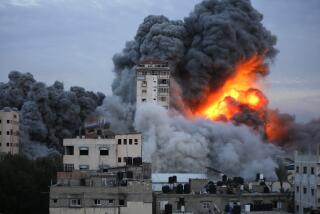Major Shift Seen With Use of ‘Smart’ Bombs
- Share via
The airborne assault on Iraq involves widespread use of new precision-guided bombs and missiles -- an innovation that will allow U.S. forces to hit their targets more accurately and sharply reduce civilian casualties, officials said Friday.
Nearly nine out of 10 bombs used in the current air campaign are expected to be guided by satellite or laser, compared with only about 10% equipped that way in the 1991 Persian Gulf War.
For the record:
12:00 a.m. June 8, 2003 For The Record
Los Angeles Times Sunday June 08, 2003 Home Edition Main News Part A Page 2 National Desk 1 inches; 45 words Type of Material: Correction
Bomb weight -- A graphic on U.S. weapons used in the war against Iraq that ran in Section A on March 22 incorrectly reported the weight of one of the bombs carried by the F/A-18E Super Hornet. The MK-84 weighs 2,000 pounds, not 3,000 pounds.
The “smart” bombs -- which are ordinary, free-falling weapons that have been modified with fins and computer chips -- are designed to land within a few feet of their target.
“The weapons that are being used today have a degree of precision that no one ever dreamt of in a prior conflict,” Defense Secretary Donald H. Rumsfeld said Friday as he criticized media reports comparing the Iraqi air campaign to World War II.
“And it’s not a handful of weapons, it’s the overwhelming majority of the weapons that have that precision,” he said of the air campaign that got fully underway Friday.
During World War II, bombing raids were notorious for destroying everything in their path except their intended targets. In one notable case, U.S. bombers flying about 800 missions were able to destroy only a tiny portion of a Japanese factory while leveling everything else around it.
Defense analysts said stepped-up use of precision bombs -- deployed extensively for the first time in Afghanistan, where about 60% of the bombs were “smart” -- is leading to a fundamental shift in warfare.
In Friday’s assault, precision bombs dropped by B-2 stealth bombers and cruise missiles launched from ships apparently hit what Pentagon officials said were key Iraqi military and leadership compounds. The claims could not be independently verified Friday.
“The reason that this is fundamentally different is that you can bomb a major city and only blow up the buildings that the bad guys are using,” said John Pike, a military analyst with GlobalSecurity.org. “World War II would have been very different if they could have just dropped the bombs on the Nazi headquarters.”
Moreover, precision weapons, particularly ones guided by satellites, allow U.S. forces to accurately hit targets in unrelenting succession, analysts said.
Television images from Baghdad showed, for instance, a number of buildings bursting into flames followed by bellowing smoke. Analysts said the images indicated that the targets were hit by satellite-guided weapons, because the attacks came in close succession and proximity to one another, even though smoke filled the sky. Smoke would have blinded laser-guidance systems, they said.
Global positioning systems have “changed everything,” Pike said. “GPS is the reason you can continually bomb with precision even with all the smoke.
“You can’t do that with” laser-guided bombs, he said. “You would have had to come back after the smoke had cleared.”
Bombs fitted with Boeing Co.’s Joint Direct Attack Munition, or JDAM, kits are expected to get considerable attention during the air campaign. More than 6,000 JDAMs, which cost about $20,000 each, have been shipped to the Persian Gulf area.
Developed during the mid-1990s and used for the first time during the war in Kosovo, a Yugoslav province, the kit turns an ordinary gravity bomb into a target-seeking “smart” weapon. The kit includes a tail fin and a small computer with a global positioning system.
A bomb that can penetrate bunkers -- the Joint Standoff Weapon, or JSOW -- also is likely to see considerable use. The latest variant also uses global positioning to pinpoint its target.
With the GPS equipment, the intended target can be changed even after the weapon has been launched.
The capability was particularly useful in Afghanistan and is likely to see greater use in Iraq. In Afghanistan, B-1B bomber crews were able to change target coordinates for their satellite-guided bombs while in flight as ground forces uncovered fresh Al Qaeda and Taliban targets.
“They were saying during Desert Storm how many sorties do we need to hit a target,” said Christopher Michel, a defense expert at military.com. “Now they’re saying how many targets can we hit per sortie.”
More to Read
Sign up for Essential California
The most important California stories and recommendations in your inbox every morning.
You may occasionally receive promotional content from the Los Angeles Times.













